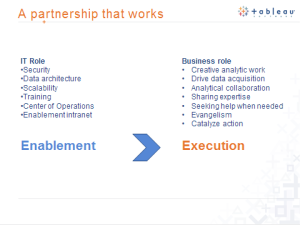Years ago, I was a programmer. Then folks started calling themselves software engineers. Of course, programming isn’t engineering. The best programmers combine science, engineering and art as do all good craftsmen, but words such as engineer and scientist hold an allure (and the potential for more money) to some people who aren’t as confident as they should be, hence such modern titles as Sanitation Engineer.
Why does that line of thought come to mind? I spent an hour yesterday listening to a TDWI webinar where one focus was on the Data Scientist when it should have been on business intelligence. The presenters were independent analyst Colin White and IBM Product Marketing Manager Brent Winsor. The typical analyst & company presenter webinar covers a key theory impacting a market and then how a specific product addresses that issue or need. Not so on Thursday.
My primary issue is the artificial split in the claim that BI concerns itself with descriptive and diagnostic analysis while data science looks towards predictive and prescriptive analysis. The main point of many of the new analytics for data mining, created by people calling themselves data scientists, is to understand patterns in large data sets. That’s clearly descriptive in nature.
Another reason that the line is artificial is a key and valid point Colin White stated as “much of predictive analytics is looking at historical data.” Numerous vendors are beginning to provide predictive analytics by starting with a base of understanding past performance and providing analytics to do what-if planning by seeing what happens as incoming data parameters are modified to simulate different conditions. If Mr. White had spent more time discussing how this evolutionary change is happening rather than inventing stalking horses, it would have been a much better presentation.
Brent Winsor’s presentation had other problems. On its own, it became rapidly clear that Mr. Winsor was reading a script rather than talking with us. That could be what happens when a marketing organization in a large company decides that, rather than helping a presenter, too much must be controlled and the “help” turns into an impediment. From what I could glean in the Q&A, Brent is sharp, knows his stuff, and can relate to the audience; but he was stifled throughout the formal presentation.
The bigger issue, though, was the Brent Winsor focused on self-service BI. While that’s of interest, I pointed out at the beginning how the consultant and company presentations should mesh. One being about data science and the other about self-service BI was not a flow that leads to a powerful overall webinar.
The only real nit I have with his presentation on its own is the issue of self-service. That is empowering the business user to create and manipulate reports and charts to wander the data without requiring IT or others to created new output for them. It makes sense and something that IBM Cognos and its competitors are enabling in the market place. However, just because self-service is important doesn’t mean everyone using the tool is interested in or availing themselves of self-service.
One view of that was Brent’s discussion of the CxO suite, folks who often don’t want to do anything, or much, to the information, they just need the high level overviews provided by their managers and business analysts so they can synthesize their own conclusions. Many only need to glance at a single drill down or other reporting capabilities in the existing, traditional tools. However, in an attempt to expand the realm of self-service to every user, Mr. Winsor and IBM have created the category of “managed/scripted” self service. If your access is being managed or if you are following data flow scripts being created by others, you aren’t self-service. We don’t have to put everything in the latest marketing basket. Brent’s points about the spectrum of BI users was dead on, I only think it was a stretch to make all users self-service users.
Not every webinar can be perfect, nor do I claim perfection for my own; but the webinar was so far from it that I came away very disappointed.
